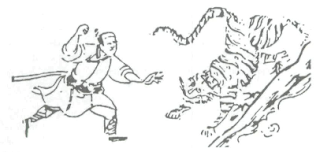
Aladdin is another Disney classic that involves the story of Princess Jasmine and the pauper Aladdin falling in love, it is a classic princess fairytale with the happy ending. As usual, Jasmine has an animal companion by the name of Rajah, and the animal is a tiger. It's a common sort of belief that the wealthy own such exotic creatures, but whether that is true or just a myth I'm not sure. What I find very curious about the scenes to the left is the anthropomorphism of the tiger, for you see the sadness in the features in the top moving gif. You even see the animal hug her back as she cries against her companion, much like we would hug our cats and dogs in times of sorrow.
This second moving gif from the movie also shows Jasmine loving on the tiger and there appears to be a happy smile on the animal's face, and in both scenes these are very different depictions of the animal that the public knows as vicious and dangerous, for in this movie it appears as if the tiger is as gently as our house cats. There is also a scene in the movie where Aladdin comes to visit Jasmine as a prince where Rajah is fiercely snarling at Aladdin, being protective of Jasmine, and portraying the image of the tiger that the public and media know.
I think the reasoning behind why they use the tiger and anthropomorphize it is to get the children to relate to the animal, to connect similar characters or emotions that make it more likable than Iago, the parrot.

I would certainly deem the Life of Pi a more adult movie as it is about a boy's survival on this boat for 227 days with this tiger. The directors and producers spent time studying tigers, which I think adds immensely to the portrayal of the animal in the movie. You can see in both gifs that the animal certainly does not have any of the anthropomorphized emotions that are shown in Rajah, in the Disney movie Aladdin. You can see how the boat ride for the boy in the movie quickly became one of life or death survival. For tigers, as predators, were certainly trying to go after the boy as prey.
This shows a more realistic version of the tiger that we would think of today or that was told in story in the past. There is nothing about that massive paw and teeth that says this animal is cute and cuddly either, so you may disassociate any connections to animals in your life.







